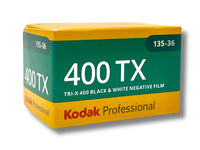Black Friday 2025 has landed at Analogue Wonderland, bringing some of our biggest film photography deals of the year - from discounted film and cameras to money-saving WonderLab processing offers, exclusive bundles, and festive specials available for a limited time only. Grab a great deal while stocks last!
Recent posts

The Eternal Debate: Kodak Tri-X vs. Ilford HP5 Plus
By Paul McKay
In the captivating world of black and white photography, the debate between Kodak Tri-X and Ilford HP5 Plus is a perennial one, filled with nuances and personal preferences. In this in-depth exploration, enriched with real customer reviews and ratings, we'll dive into the 'Kodak Tri-X vs Ilford HP5 Plus' discussion, comparing these two legendary films in various aspects to help you make an informed choice.
The Historical Significance and Community Ratings
Kodak Tri-X, a film synonymous with classic black and white photography, has been capturing life's moments since 1940. Its enduring legacy is a testament to its adaptability and robustness. On the other side, Ilford HP5 Plus, which rose to prominence in the 1980s, has carved out its own niche, renowned for its fine grain and remarkable versatility.
In terms of user satisfaction, our community's ratings speak volumes, with Ilford HP5 leading slightly at an impressive 4.97 out of 5 and one of the best 35mm films, compared to Kodak Tri-X's still admirable 4.94.

"Ilford HP5+ is my favourite B&W film. It gives consistent and great results" @jan.onfilm
Grain and Contrast: Through the Lens of Photographers
Grain structure, a crucial element in black and white film photography, is a defining characteristic of these films. Kodak Tri-X is celebrated for its distinctive grain, which Oliver Franklin eloquently appreciates, saying, "Recently pushed this film to 6400 ISO... with very little grain! A lovely film to work with." This grain quality adds a texture and depth to images, making them almost tactile. Conversely, Ilford HP5 Plus offers a more subdued grain profile. Christopher Simpson expresses, "It shoots amazingly well in all lighting situations and can be pushed up to 1600/3200 without losing much detail," highlighting its finer grain quality.
Contrast is another crucial aspect where these films diverge. Tri-X is renowned for its punchy contrast, which gives images a dramatic and bold look. This characteristic makes it ideal for striking portraits and compelling street photography. In contrast, HP5 Plus offers a more nuanced and balanced contrast, lending itself well to a wider range of lighting conditions and providing greater flexibility in post-processing.
Personally this is why I prefer Tri-X - my instinct as a film photographer is to lean into higher contrast and more dramatic imagery - and I've always found Tri-X to deliver in spades!

Paul shooting on Kodak Tri-X, shot on Kodak Tri-X 😂
Exposure Latitude: A Deep Dive into User Experiences
Exposure latitude is an important consideration for many photographers, especially those shooting in variable lighting conditions. Ilford HP5 Plus is often praised for its generous latitude, as Thomas Wesley observes, "It's really easy to work with, giving you lots of room for error or experimentation." This quality makes it a forgiving film for beginners and a versatile choice for experienced photographers. Kodak Tri-X, while not as forgiving, is known for its predictable and consistent results, making it a reliable choice for those who value precision. Stephane's reflection on Tri-X underscores this: "TriX never disappoints with its quality, contrast, and richness of a monochrome image."

"My first time using Tri-X as I wanted to try something different to my usual black and white go to, and I really liked the results!" @hollygoodenough
Exposure latitude not only affects the ease of shooting but also impacts the final look of the photograph. HP5 Plus, with its ability to handle over and underexposure gracefully, is ideal for capturing scenes with complex lighting. You can read more about HP5 in our Ilford HP5 Film Review.
On the other hand, the precise nature of Tri-X can be leveraged to create images with a clear vision and strong impact, particularly in high-contrast scenes.
The Art of Developing: Insights from Darkroom Aficionados
The developing process is where photographers can further influence the character of their images. Emma, a darkroom enthusiast, shares her affinity for HP5: "I love experimenting with HP5 in different developers. Each time, it's like discovering a new aspect of the film." This adaptability in the development process allows for a wide range of artistic expressions. Kodak Tri-X also offers significant flexibility in development, as noted by Antony Mo: "The standout grain... makes for distinctive images." Its tolerance to various developing techniques makes it a favourite for those who like to experiment in the darkroom.

"I was so excited about trying out this film, hoping for contrast and nice dark shadows, and it didn't disappoint" - Shot on Kodak Tri-X @LeeShootsFilm
Both films respond well to standard and alternative developing processes, allowing photographers to manipulate contrast, grain, and tonal range. This flexibility is essential for those who view the developing process as an integral part of their creative workflow, offering a means to imprint their personal style onto the final image.
If you don't want to develop at home then you can always send in to Analogue Wonderland's in house-lab for B&W film development! Using a professional lab is fast, easy, and allows you to focus more time on shooting!
Push Processing: Expanding Creative Boundaries
Push processing is a technique used by photographers to adapt film to different lighting conditions, and both Tri-X and HP5 Plus excel in this regard. Fabio Caponetti praises Tri-X: "No matter how the light is, it produces stunning results." This ability to push the film beyond its nominal speed makes Tri-X a versatile choice for low-light and high-speed photography. HP5 Plus is equally capable in push processing, as Jack highlights: "If I had to choose a reliable and beautiful black and white film, it would be HP5." This flexibility is particularly beneficial for photographers who often find themselves shooting in unpredictable lighting conditions.
The impact of push processing on the aesthetic qualities of the film is significant. Pushing Tri-X can enhance its grain and contrast, lending a gritty and raw feel to the images. HP5 Plus, when pushed, maintains its finer grain structure and more subtle contrast shifts, making it suitable for maintaining detail and nuance in shadow areas.

"I've pushed and pulled this film massively and it has always produced great results in a variety of locations" - Joseph
Conclusion
In conclusion, the choice between Kodak Tri-X and Ilford HP5 Plus is not just about technical specifications; it's about how these films align with your creative vision and approach to photography. Both films are celebrated for their unique characteristics, as reflected in the ratings and reviews from our community. The fact that both are also available in other formats: Ilford HP5 120 film and Kodak Tri-X 120 film - helps their wide appeal. And whether it's the textured, dramatic look of Tri-X or the smooth, versatile nature of HP5 Plus, each film offers a distinct canvas for your photographic storytelling. If you're looking for even more options, have a look at our Top 6 B&W films showdown!
As you explore the world of black and white film photography, we encourage you to experiment with both these iconic films. What has been your experience with Kodak Tri-X and Ilford HP5 Plus? Do you have a preference, or do you find each has its place in your photography repertoire?
Ready to dive in?
Keep Reading
View all
Christmas 2025: Shipping & Opening Hours
Christmas 2025 is fast approaching! To make sure your analogue goodies arrive in time, take note of our last shipping dates, plus opening and operating hours over the festive season. We've got everything you need to gift the magic of film photography this Christmas!

Film Photography Christmas Gift Guide 2025: Analogue Wonderland
Capture the magic of Christmas with film - no filters needed. Our 2025 Film Photography Christmas Gift Guide 2025 is packed with thoughtful presents for every type of shooter, from curious beginners to seasoned photographers. Discover film stocks, cameras, and creative accessories that will make this festive season truly memorable.
Subscribe to our newsletter 💌
Sign up for our newsletter to stay up to date on film photography news, sales and events:
Free Tracked Shipping
On all UK orders over £50
Passion For Film
An unbeatable range and an on-site lab
Our Customers Trust Us
Thousands of independent 5* reviews
All Deliveries are Carbon Neutral
Independently audited and verified by Planet
- Opens in a new window.








12 Comments -
Alan Fisk • -
Keith • -
Solly • -
Prakash • -
Gordon Hunter •
1 2 3 →
I’m soon about to use my last roll of HP5+, and then I’m changing back to Tri-X, even if it’s not quite what it was (and, at 75, nor am I).
For those like me who like snappy contrast, I recommend Ilford Ortho Plus, if you are willing to accept its speed of ISO 80, and, of course, its orthochromatic rendering of colours.
I have used both the old Tri-X (TX) and the latest Tri-X (400TX) and they’re both good films
However, I prefer HP5 Plus to both of them.
I could happily use this film for the rest of my life, although I sometimes switch to FP4 Plus on sunny days.
All the films get processed in a standard D-76/ID11 developer diluted 1+1.
i have tried numerous films over the years, still a film aficionado , the original Tri X from it’s earliest times is def not the one being sold today, i find i need to use filters to enhance the contrast, Yellow, orange and sometimes a deep Red to darken the sky, Blue filter to improve Male portraiture, a red for female beauty esp in clear skin. depending on what chemicals are used, like Microphen,etc, the end result can either be stunning or really disappointing. as a footnote i must also highly recommend Ilford’s SFX as a truly stunning film, esp used with a red filter, ppl need to try this film, as the deep blacks are almost velvety,used in a shadowy light it transforms a normal scene to a remarkable visual feast.
The current Tri-X is not the Tri-X of the 20th Century. The formula changed in about 2007 to reduce silver content and reduce grain, that’s about the time I first tried Ilford HP5+ but still preferred the reformulated Tri-X. (I can’t find any official Kodak articles rolling out the change but refer to: https://www.johnnypatience.com/blog/the-shared-soul-of-kodaks-legends#:~:text=Changes%20in%20Tri%2DX%20400&text=One%20significant%20update%20occurred%20in,of%20TX%20or%20TX400%E2%80%8B.) Modern Tri-X is still a great film; however these days, I useHP5+ but use black and white filters (yellow, yellow/green, orange and occasionally deep red and green) manipulate contrast.
For a film comparison article, this article has, in my opinion, too many words and not enough photos. A total of 5 photos doesn’t even give the same number of examples for each film. Also, it would be far more relevant and useful to someone wanting to know which film to choose, if you’d taken the same shots with both films, so that we could see how each renders the same scene differently.